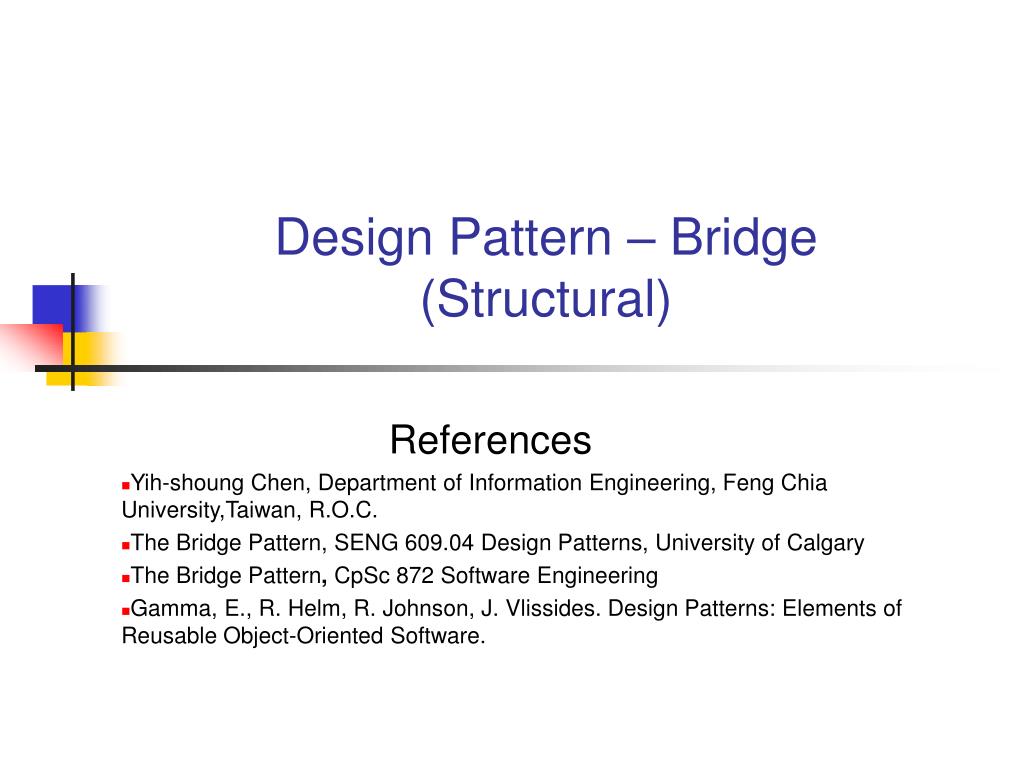Table Of Content

So you're working on a new software project and about to reach the testing phase.That's great news! But have you considered the different testing types you need to perform? Great article, I read 2 prior articles which described this pattern, but in no way demonstrated why you would ever have a need to use it.
Types of Behvioural Patterns
This interface has three methods (SwitchOff, SwitchOn, and SetChannel). This Interface acts as a bridge between the abstraction classes and implementor classes. This Interface defines the operations for all implementation classes. The Adapter (139) pattern is geared toward making unrelated classes work together. Bridge, on the other hand, is used up-front in a design to let abstractions and implementations vary independently. The Bridge classes are the Implementation that uses the same interface-oriented architecture to create objects.

Design Patterns — A quick guide to Bridge pattern.
Whenever we use Inheritance, our implementations (child classes) and the abstractions (parent classes) are generally coupled (dependent) on each other. This is because the implementations implement or extend the abstractions depending upon whether the abstraction is an abstract class or an interface. In these cases, we can use the Bridge Design Pattern to decouple this dependency. The abstraction object controls the appearance of the app, delegating the actual work to the linked implementation object. Different implementations are interchangeable as long as they follow a common interface, enabling the same GUI to work under Windows and Linux.
Introducing Bridge Pattern
You can set up the path externally in your Operating System to select a specific version. That selection would be considered as the “Bridge” between what applications want and what the actual versions they would get, so it is many-to-many mapping for you. If I understood this article correct, first schema addresses the state before, and UML diagram addresses the state after applying Bridge pattern. If that’s what you meant to show, I guess that schema is not correct. Arrows from RedColor and GreenColor towards Triangle and Pentagon, should be pointing vice-versa.
The Bridge design pattern allows you to separate the abstraction from the implementation. The Adapter pattern is similar to the Bridge pattern since both act as intermediaries between the two system’s components. The Adapter pattern makes the two non-compatible components work together.
Creational Design Patterns
You would prefer to say that each Shape has a Color and to implement a hierarchy of colors, and that is the Bridge Pattern. Well, I wouldn't implement a "hierarchy of colors", but you get the idea... Here, our abstraction (general idea of the objects) is the View and the specific kind of view like LongView or ShortView is our implementation (specific implementation of the object). When a class varies often, the features of object-oriented programming become very useful because changes to a program's code can be made easily with minimal prior knowledge about the program. The bridge pattern is useful when both the class and what it does vary often.
In the next article, I will discuss Real-Time Examples of Bridge Design Patterns using C#- Send Messages. In this article, I try to explain the Bridge Design Pattern in C# with Examples. I hope you understand the need and use of the Bridge Design Pattern in C# with Examples. The first layer is the Abstraction Layer, and the second layer is the Implementation Layer.
By the way, this last item is the main reason why so many people confuse the Bridge with the Strategy pattern. Remember that a pattern is more than just a certain way to structure your classes. This type of bridge contrasts to suspension bridges as the cables span directly from the towers or pylons as opposed to being suspended vertically from a cable.
They are working with numerous API providers of a specific type and support multiple types of database servers. In that case, you can surely use the Bridge design pattern to make things easy for yourself. Bridge design pattern can be used when both abstraction and implementation can have different hierarchies independently and we want to hide the implementation from the client application. Create an interface named ILEDTV.cs and copy and paste the following code into it.
For example, you can add a new TV (Panasonic TV) in the Implementation Layer, which will not affect the Abstraction Layer. You can also add a new Panasonic TV Remote Control in the Abstraction Layer without affecting the Implementation Layer. So, this is one of the best examples of the Bridge Design Pattern. In this post, We will see how to format and work with date objects in thymeleaf templates using the #dates utility with an example. Introduction Before getting in further, read a little about thymeleaf and how it can help build dynamic web applications.
College of Architecture Professor's New Bridge Is the First of Its Kind - IIT Today
College of Architecture Professor's New Bridge Is the First of Its Kind.
Posted: Mon, 20 Apr 2020 07:00:00 GMT [source]
A monolithic class having numerous adaptations or alternatives of some functionality often needs to be divided and organized to make the design easy and avoid complications. However, there can be a lot of complications with such classes since it is not easy to make changes as it will take more time and effort to make any amendments. Also, it would be more difficult to comprehend it, and minor changes will lead to complex and massive errors. So Bridge pattern will provide the perfect solution for this by dividing the monolithic class into various classes such that each hierarchy is entirely independent of the other. Hence it will make the code easy to understand and make changes.
The UML diagram below shows the sample implementation of the Bridge design pattern in C#. The above image shows that the bridge design pattern consists of four participants. Create a class named AbstractRemoteControl.cs and copy and paste the following code.



No comments:
Post a Comment